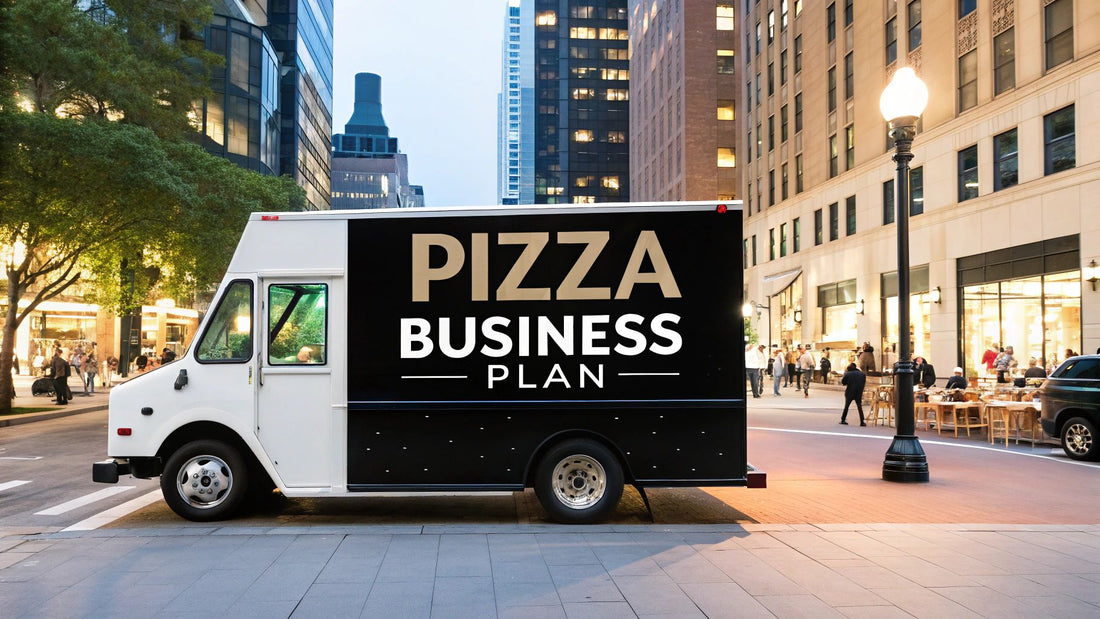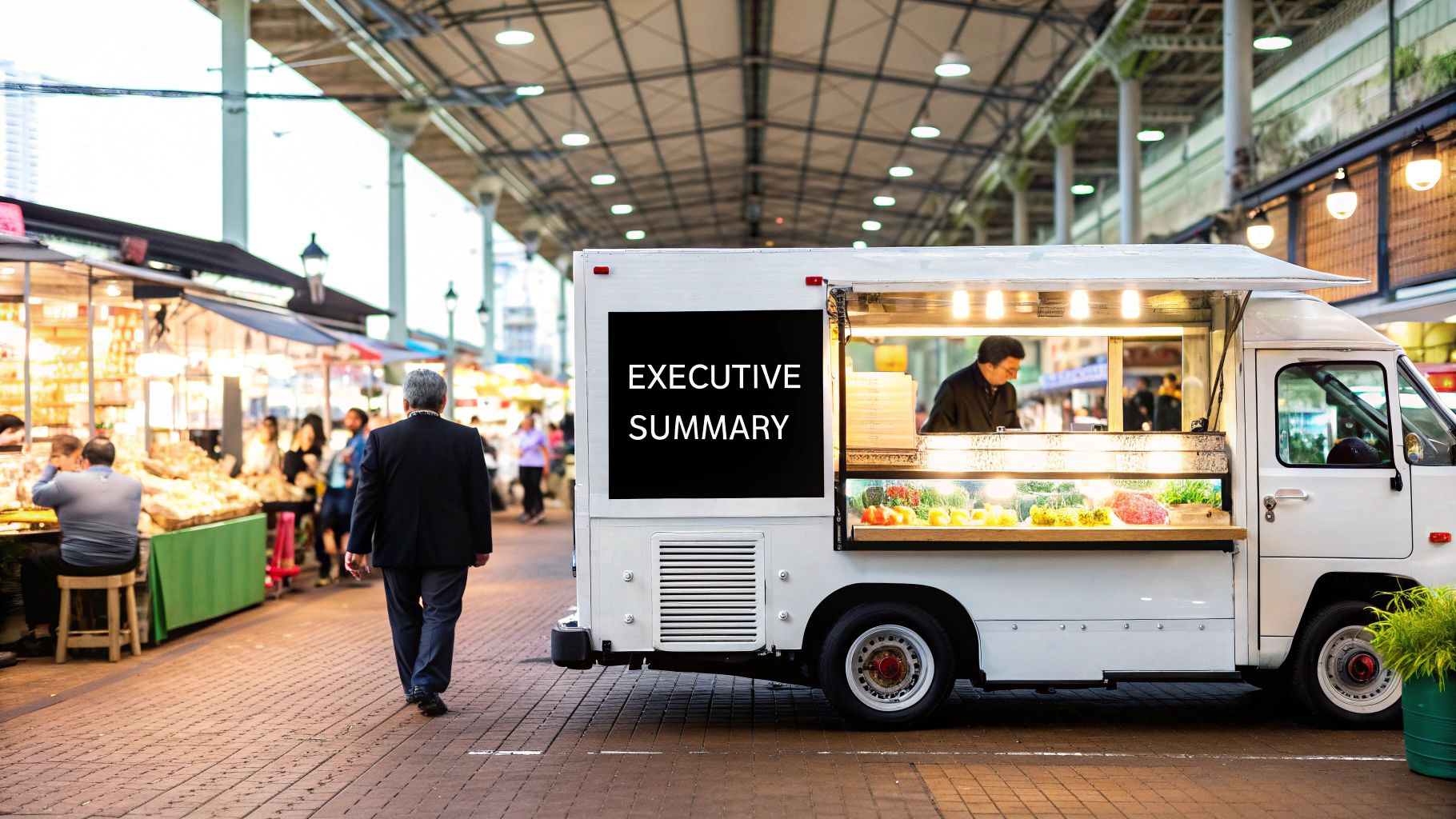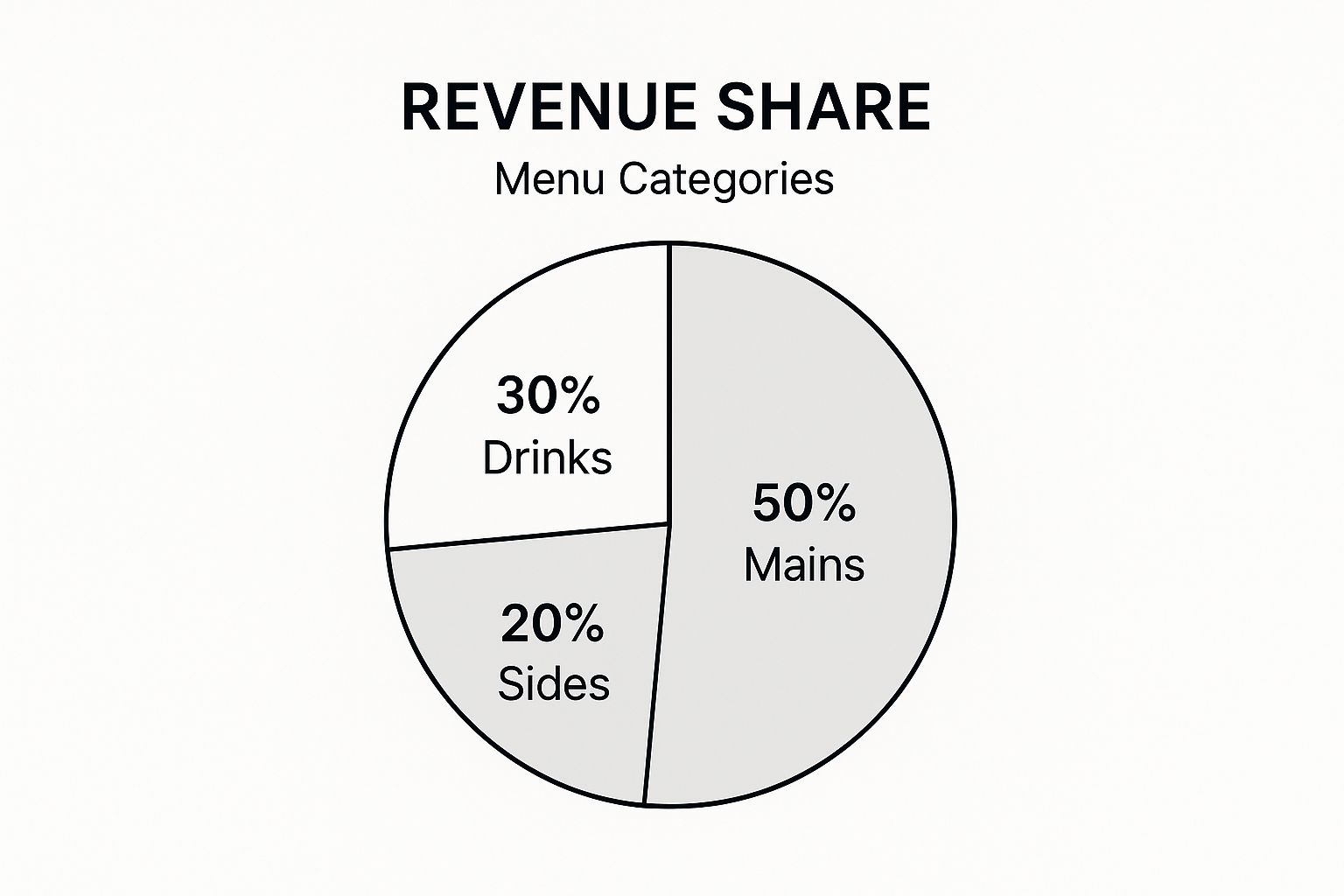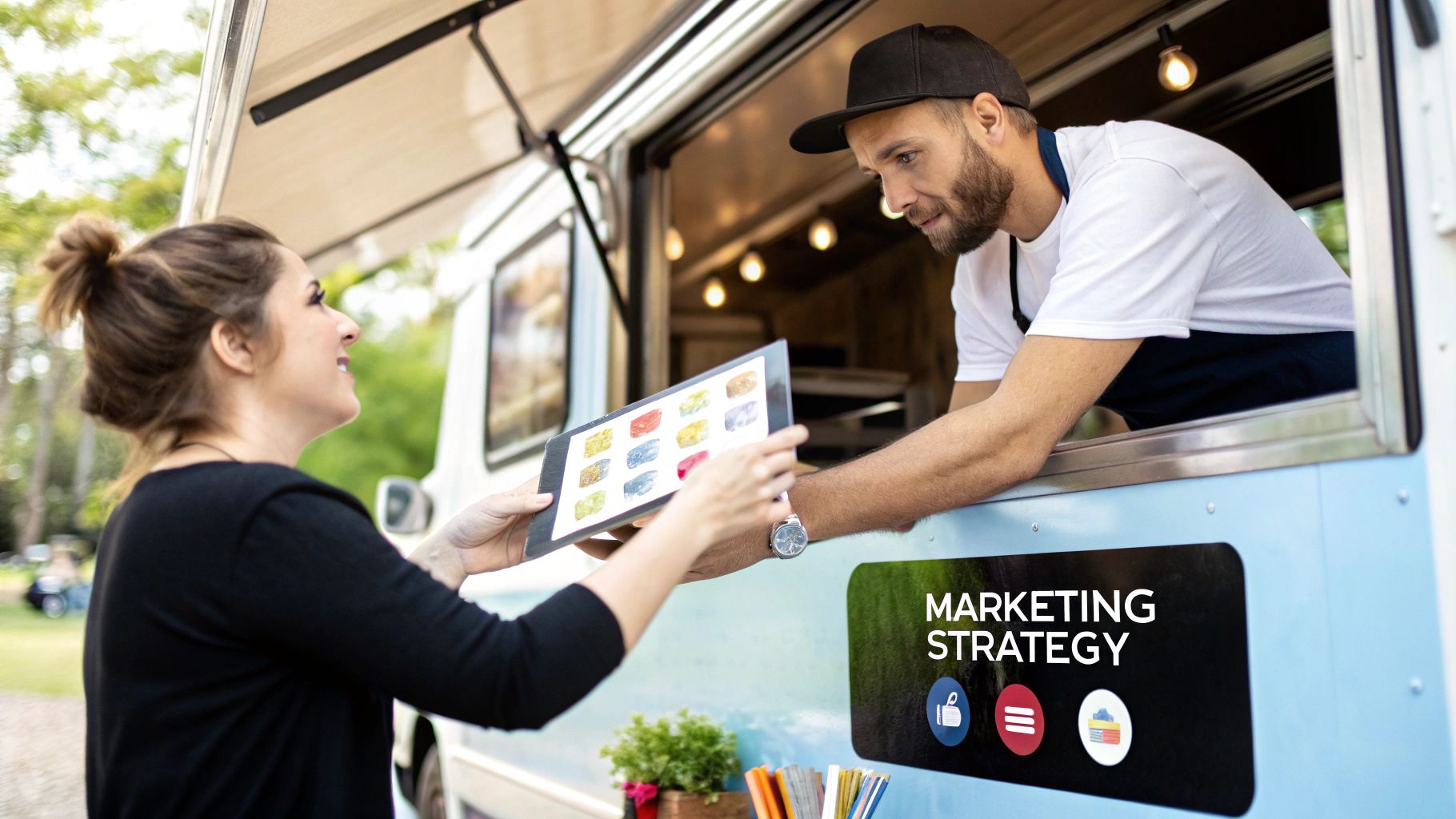
A Winning Food Truck Business Plan for Your Pizza Venture
Share
A solid food truck business plan isn't just a document for the bank. It's the single most important tool you'll create for your mobile pizza venture. Think of it as the detailed blueprint that guides every single decision you make—from menu design to securing funding—and keeps you grounded when you're facing the real-world challenges of running a business on wheels.
This plan is what turns your passion for pizza into an actual, profitable operation.
Building Your Blueprint for a Profitable Pizza Truck
Long before you fire up the first oven or scout your first parking spot, a successful pizza food truck begins with a rock-solid business plan. This is your strategic roadmap, the foundation for everything that follows. It will influence your choice of a high-efficiency pizza prep table, pinpoint your prime locations, and shape your entire marketing approach.
A great plan forces you to get brutally honest about four essential pillars:
- Deep Market Analysis: Who are your customers, really? And who are you up against?
- Streamlined Operational Strategy: How will you get from raw dough to a finished pizza in a customer's hand, day in and day out?
- Savvy Marketing Plan: What's going to make people drive past three other pizzerias to find your truck?
- Airtight Financial Planning: You need realistic numbers. This means projecting costs, revenues, and profitability without wearing rose-colored glasses.

Why Your Pizza Truck Needs a Business Plan
Let's be clear: a well-crafted plan does more than just organize your thoughts. It proves the viability of your pizza concept to potential investors, lenders, and most importantly, to yourself. It forces you to ask and answer the tough questions about every single part of the business before you've spent your first dollar.
For a pizza restaurant on wheels, efficiency is everything. The right equipment, like a properly sized pizza prep table, can be the difference between a chaotic service and a profitable one. Your business plan is where you justify these crucial investments.
The food truck scene isn't just a fad; it's a dynamic and growing industry fueled by people who want convenient, high-quality food. With the global food truck market projected to hit USD 5.8 billion by 2025, the opportunity is massive. This trend confirms that with the right strategy, a mobile pizzeria can absolutely capture a significant slice of the market.
Before we dive into the specifics, let's look at the core components every pizza food truck business plan must have. This table breaks down what you need to focus on to create a document that truly works for you.
| Section | Key Focus for a Pizza Truck | Primary Goal |
|---|---|---|
| Executive Summary | A compelling snapshot of your pizza concept and financial ask. | To grab an investor's attention and make them want to read the whole plan. |
| Company Description | Your mission, what makes your pizza unique, and your legal setup. | To clearly define your brand identity and business structure. |
| Market Analysis | Target customers, local pizzerias, and location strategy. | To prove you've found a profitable niche in your local market. |
| Organization & Management | Your team's experience and roles. | To show you have the right people to execute the plan. |
| Menu & Operations | Your pizza menu, sourcing, food costs, and daily workflow. | To detail how you'll consistently produce and sell a great product. |
| Marketing & Sales | Branding, social media strategy, and how you'll attract customers. | To outline your strategy for building a loyal customer base. |
| Financial Projections | Startup costs, profit & loss, cash flow, and break-even analysis. | To demonstrate the financial viability and profitability of your venture. |
This framework ensures you cover all the bases, creating a comprehensive guide for your launch and a compelling case for anyone considering funding your dream.
For a complete walkthrough, learning how to write a comprehensive business plan is an invaluable next step. Mastering these components will not only help you attract investment but will also set you on a clear, confident path to success from day one.
Analyzing the Market to Find Your Niche
Before you even start daydreaming about the perfect dough recipe or which pizza prep table will fit in your truck, you have to hit the streets. Metaphorically, at least. A winning food truck business plan isn't built on a great recipe alone; it's built on knowing your local food scene inside and out. This is where you find your competitive edge before you ever serve a single slice.
It all boils down to one question: Who are you trying to feed? Get this right, and everything else falls into place.

Pinpointing Your Ideal Customer
You can't be everything to everyone, especially when your kitchen has wheels. Trying to please the masses is the fastest way to get lost in the crowd. The real magic happens when you get laser-focused on who you want to serve.
Think about who you'd see lining up at your window:
- The Weekday Lunch Crowd: These are office workers in business parks or downtown looking for something fast, delicious, and not ridiculously expensive. For this group, speed is everything.
- Families at Community Events: Picture weekend soccer games, farmers' markets, or local festivals. This crowd is looking for kid-friendly options and a fun, approachable vibe.
- The Late-Night Scene: Parking near bars, concert venues, or a college campus means serving people who want something satisfying and easy to eat after a night out.
- Corporate Catering Clients: Lots of businesses are tired of the same old sandwich platters for meetings. This is a totally different service model, but it can be incredibly profitable for a pizza restaurant.
Once you have a primary audience in mind, you can build your entire concept around them—from the menu right down to the wrap on your truck. This focus makes your marketing punch harder and keeps your operation lean.
Sizing Up the Local Competition
Alright, time to put on your detective hat. Your competition isn't just the other pizza truck across town. It's any place someone can grab a quick, tasty meal. This means brick-and-mortar pizzerias, other food trucks, and even the popular fast-casual chains.
Fire up a simple spreadsheet and start scouting. For every competitor, jot down:
- Menu & Price: What are they selling? What's the price for a slice versus a whole pie?
- Location & Hours: Where do they park and when are they slammed? Are they always in the same spot?
- Strengths: What do they absolutely nail? Is it their lightning-fast service, crazy toppings, or their huge Instagram following?
- Weaknesses: Where are the cracks? Do people complain about long waits? Limited drink options? A boring brand?
This isn't just busy work; it’s where you find your opening. Maybe nobody is doing a killer vegan pizza, or all the good lunch spots downtown are closed by 3 PM. These gaps are your golden opportunities.
A classic mistake is ignoring the old-school local pizzeria. They might not be mobile, but they’ve got a loyal following and a full-size kitchen. Your plan needs to show exactly how you'll offer something they can't—whether that's convenience, a unique culinary style, or just a better experience.
The food truck scene is booming for a reason: it's adaptable. The industry hit about USD 2.8 billion in the U.S. in 2025, riding a 13.2% compound annual growth rate over the five years prior. A big part of that growth comes from trucks that cater to specific tastes, like the vegan and vegetarian options blowing up in cities. For a deeper dive into these trends, you can discover more insights about the food truck industry.
Defining Your Unique Selling Proposition
Now that you have a clear picture of your customers and the competition, you can figure out what makes your pizza truck special. This is your Unique Selling Proposition (USP)—the single, powerful reason customers should pick you.
Your USP needs to be clear, believable, and something you can deliver on every single day. It's the soul of your brand and the north star for your entire operation.
Think about what your hook could be:
- The Speed Specialist: "Artisan Pizza in Under Three Minutes." This promise demands a super-efficient workflow, a tight menu, and a beast of an oven.
- The Local Purist: "Farm-to-Truck Pizza with 100% Locally Sourced Ingredients." This plays well with foodies and community-focused customers but means building solid relationships with local farms.
- The Dietary Innovator: "The Best Gluten-Free and Vegan Pizza on Wheels." You’d be targeting a smaller but incredibly passionate and often ignored niche.
- The Authenticity Expert: "True Neapolitan Pizza from a Certified Wood-Fired Oven." This is all about craft and tradition, aimed squarely at pizza purists.
Your USP has a direct impact on your gear. A USP built on speed means your pizza prep table has to be laid out for maximum efficiency, with refrigerated compartments right where you need them to minimize steps. Your USP isn't just a tagline for your website; it's an operational promise that shapes every single part of your food truck business plan.
Designing Your Menu and Outfitting Your Kitchen
This is where your food truck dream starts to get real. Moving beyond spreadsheets and ideas, your menu and kitchen design are the engine of your entire operation. They dictate your brand, your workflow, and, most importantly, your profits. Thinking about them together isn't just a good idea; it's the only way to build a mobile pizza business that works.
In a food truck, simplicity is your best friend. A bloated menu is a recipe for disaster—it slows down service, creates more waste, and gives customers decision fatigue. Keep it tight. Focus on a core offering of 5-7 knockout pizza options that you can nail every single time. That’s how you build a reputation for quality and consistency that keeps people coming back.
Crafting a Profit-Driven Pizza Menu
Every item on your menu needs to earn its spot. Start with a crowd-pleaser, like a classic Margherita or pepperoni. These are your anchors. From there, get creative with a few signature pies that show off your brand's personality. Maybe that's a killer vegetarian option or a gourmet pie with unique toppings. This approach hits all the right notes without overwhelming your tiny kitchen.
Remember, every ingredient takes up precious space and costs money. The secret sauce to a profitable food truck menu is maximizing ingredient overlap. The fresh basil on your Margherita pizza? Use it for a pesto drizzle on a specialty pie. This simple strategy cuts down on waste and makes ordering supplies way easier—a lifesaver when you're working in a kitchen on wheels.
While the pizza is the main event, don't sleep on your sides and drinks. They can easily make up half your revenue.

As you can see, a smart selection of sides and drinks can seriously boost your average ticket price, turning a good day into a great one.
Choosing Your Kitchen Command Center: The Pizza Prep Table
If your truck has a heart, it's the pizza prep table. This isn't just a countertop; it's your entire assembly line, combining refrigerated storage for toppings with a durable workspace. Picking the right one is one of the most critical decisions you'll make for your pizza restaurant.
Your prep table sets the pace for your entire service. A well-designed station lets your crew fly, moving from dough to oven in seconds. When the lunch rush hits, that speed is everything. It's also your first line of defense for food safety, keeping everything from cheese and meats to fresh veggies held at a safe, consistent temperature.
The layout of your pizza prep table dictates your entire kitchen's workflow. An inefficient setup can add 30-60 seconds to each pizza's assembly time. Over a hundred orders, that's over an hour of lost service time and potential revenue.
There are three main styles of pizza prep tables, and the right one for you depends on your menu, truck layout, and how many pizzas you plan on slinging.
Pizza Prep Table Feature Comparison
Choosing the right prep table for a food truck is all about maximizing a tiny space. Your decision will come down to how many toppings you offer versus how much bulk storage you need right at the prep station. This table breaks down what each type brings to the table.
| Feature | Standard Prep Table | Mega-Top Prep Table | Drawer-Based Prep Table |
|---|---|---|---|
| Topping Capacity | Offers a standard number of ingredient pans, ideal for simple, focused menus. | Provides 25-50% more pan capacity by extending the refrigerated rail, perfect for diverse toppings. | Features refrigerated drawers below the work surface for bulk storage of dough or cheese. |
| Best For | Trucks with a streamlined menu of 3-5 classic pizzas and limited space. | High-volume trucks with a complex menu requiring many different fresh ingredients. | Pizza operations that prioritize bulk cold storage and want to reduce trips to a separate refrigerator. |
| Workflow Impact | Promotes a simple, linear workflow. | Allows for faster assembly of complex pizzas without leaving the station. | Excellent for keeping backup ingredients within arm's reach, minimizing downtime. |
Ultimately, a mega-top is for menu variety, drawers are for bulk efficiency, and a standard table is the space-saving classic. Match the table to your menu, not the other way around.
Outfitting the Rest of Your Mobile Pizzeria
While the prep table is the star, it needs a strong supporting cast. Your oven, for example, is a huge part of your brand identity. A traditional wood-fired oven screams authenticity but takes up a lot of space and requires a skilled operator. On the flip side, a modern conveyor or deck oven delivers speed and consistency, perfect for pumping out pies during a festival.
Refrigeration is another absolute must-have. Beyond your prep table, you'll need at least one under-counter or reach-in fridge for things like dough boxes, sauces, and drinks. You’ll probably need a separate freezer, too, for items like frozen meats or other key ingredients.
Finally, don't sweat the small stuff—it's what keeps the gears turning:
- Dough Mixer: If you’re making dough on the truck, a commercial spiral mixer is a non-negotiable workhorse.
- Sinks: The health department will insist on a three-compartment sink (for wash, rinse, sanitize) and a completely separate handwashing sink. No exceptions.
- Fire Suppression System: This is a legal requirement just about everywhere and an absolute necessity for safety.
- POS System: You need a reliable point-of-sale system that can handle cards, taps, and mobile payments quickly and without a fuss.
For a deeper dive, our guide on what equipment a food truck needs breaks down everything required to build a kitchen that’s ready to roll. Getting your truck outfitted correctly from day one saves you from expensive headaches and frustrating bottlenecks later on.
Navigating Permits and Daily Operations
Your pizza might be the stuff of legends, but without the right paperwork, your truck will be parked permanently before you sell a single slice. This is the part of your food truck business plan where we get into the nitty-gritty—the less glamorous but absolutely critical world of permits, licenses, and the daily grind of running a mobile kitchen.
Getting this right is the difference between a thriving business and one that’s shut down by the health department. The bureaucracy can feel like a mountain, but if you break it down piece by piece, it’s completely manageable. Every city has its own rulebook, and there are no shortcuts. This is about protecting your investment and making sure you’re 100% legal from day one.

Getting Your Licenses and Permits in Order
Think of your permits as the keys to your truck. Without them, you’re not going anywhere. The specific requirements change from county to county, but you can bet you'll need some combination of these to get rolling.
- Business License: This is the basic ticket to the game—registering your company with your local government.
- Health Department Permit: Get ready for an inspection. They’ll scrutinize everything from your pizza prep table’s temperature logs to your handwashing station to ensure you meet food safety standards.
- Mobile Food Vendor Permit: This is the specific license that legally allows you to operate a food truck in your city or region.
- Food Handler's Permits: You and every single person working on your truck will need to pass a certified food safety course.
This process takes time, so start early. For a deeper dive, our guide on food truck permit requirements has a checklist to get you started. My best advice? Get on the phone with your local health and business departments now.
Nailing Down Your Daily Operational Workflow
Once you’re legal, your focus has to shift to pure efficiency. A food truck is a tiny, fast-paced kitchen on wheels. A clunky workflow during a lunch rush will absolutely tank your sales and stress everyone out. Your operational plan needs to map out every task from the moment you wake up to when you lock up for the night.
This means creating a system for everything. Your morning prep needs to be a well-oiled machine: dough proofed, toppings chopped, and your pizza prep table stocked and ready before you drive to your first spot. A typical day is a constant cycle of prep, service, and cleanup, and each phase needs its own playbook.
Your daily workflow isn't just about moving fast; it's about eliminating stress and mistakes. A disorganized truck leads to burnt pies, wrong orders, and unhappy customers. A smooth, practiced system builds a reputation for being quick and reliable.
The goal is to shave off seconds and maximize output. Think about the layout. Is your low-boy fridge right next to the prep station so you can grab dough without taking three steps? Are your pizza boxes stored within arm's reach of the oven? These tiny details make a massive difference when there’s a line of 20 hungry people staring at you.
Smart Inventory and Staffing Strategies
There are few worse feelings than running out of mozzarella during a Friday lunch rush. That’s a rookie mistake, and smart inventory management prevents it. Use a simple "first-in, first-out" (FIFO) system to keep ingredients fresh and track your sales data to predict what you'll need. This stops you from over-ordering produce that will spoil while ensuring you never run out of the crowd-pleasers.
Staffing is another piece of the puzzle. You might fly solo at first, but success means you’ll eventually need a crew. You need people who are fast, friendly, and don't get claustrophobic working in tight quarters.
In your business plan, define these key roles clearly:
- Order Taker & Cashier: This person is the face of your truck, greeting customers, running the register, and keeping the line moving smoothly.
- Pizza Maker: This role is all about speed and consistency—assembling perfect pizzas at the prep table without missing a beat.
- Oven Master & Finisher: This person manages the oven, boxes the pizzas, and gets them into the cashier's hands for service.
By detailing these legal and operational plans, you’re not just filling out a template. You’re proving to investors—and more importantly, to yourself—that you’ve thought through what it really takes to run a successful pizza truck.
Forecasting Your Finances and Securing Funding
This is where the rubber meets the road. A killer pizza concept and a slick-looking truck are fantastic, but they don't mean a thing if the numbers don't add up. Investors, lenders, and even you need to see a clear path to profitability. This section of your business plan is where you prove your mobile pizzeria isn't just a passion project—it's a smart financial bet.
Think of it as telling your financial story. You need to show you’ve thought through every single expense, from the high-efficiency pizza prep table down to your first order of mozzarella, and have a legit strategy for actually making money.
Estimating Your Startup Costs
Before you can ask for a dime, you have to know exactly how many dimes you need. Tallying up startup costs can feel like staring up at a mountain, but if you break it down into smaller pieces, it's totally manageable. These are the one-time costs to get your truck from an idea on paper to a running business ready to serve its first customer.
Your big-ticket items will probably fall into these buckets:
- The Truck and Build-Out: This is your monster expense. Whether you're buying new, used, or getting a custom build, you need to budget for all the guts—plumbing, electrical, and getting that kitchen equipment installed properly.
- Kitchen Equipment: Here's where you list your oven, fridges, and that all-important pizza prep table. Don't skimp here. A quality prep table isn't just another line item; it's a direct investment in your speed and food safety, which translates directly to how much money you can make each day.
- Initial Inventory: You've got to stock the shelves before you can open the window. This means having enough flour, sauce, cheese, toppings, and drinks to get you through your first couple of weeks.
- Licenses and Permits: Get ready for paperwork. Budget for everything you need to operate legally, like health permits, business licenses, and vehicle registration.
- Initial Marketing and Branding: This is your truck wrap, logo design, menu printing, and getting your social media and website off the ground.
Fire up a spreadsheet and start getting detailed. Research your suppliers, get real quotes for equipment, and whatever you do, add a contingency fund of 15-20% on top of your total. Trust me, something unexpected will come up.
Projecting Your Financial Future
Okay, you've figured out what it costs to get started. Now, it’s time to predict the future. These financial projections are the heart of this section, showing investors that your truck has the potential to be a real money-maker. You'll need to create three key documents.
First up is your Sales Forecast. This is your educated guess on how much you'll sell. Anchor this in your market research. For example, if you snag a spot at a busy downtown lunch corner, estimate how many pizzas you can realistically sell per hour. Multiply that by your average price, then project it out for the week, month, and year. It's better to be a little conservative here.
Next is your Profit and Loss (P&L) Statement. This shows if you're actually making a profit. It takes your sales forecast and subtracts all your ongoing costs—ingredients, fuel, insurance, staff wages, you name it. This tells you, over time, if you'll be in the black or the red.
Finally, there's the Cash Flow Analysis, which is arguably the most critical piece for a new business. It tracks the real cash coming in and going out every month. This is crucial because it helps you see when you might have a slow month, ensuring you always have enough cash on hand to pay the bills, even before you're rolling in profits.
Your break-even point is the magic number. It’s the answer to the question, "How many pizzas do we need to sell just to cover our costs?" Knowing this figure—for instance, "We need to sell 450 pizzas a month to break even"—gives you a concrete sales target to aim for every single day.
Exploring Your Funding Options
With your financial projections looking sharp, you're ready to go find the money. Most food truck owners pull from a few different sources to get rolling. The good news is, the industry is strong and investors know it. The global food truck market hit USD 5.42 billion in 2024 and is projected to keep growing, which gives lenders confidence.
Better yet, the "boxes" segment—which is where most pizza truck builds fall—claimed the largest revenue share at 37.1%. This shows it's a proven and popular model. You can read the full research about the food truck market to see more on these trends.
Here are a few common roads to getting funded:
- SBA Loans: Backed by the Small Business Administration, these loans are often friendlier to new entrepreneurs with more favorable terms.
- Equipment Financing: This is a loan specifically for buying your kitchen gear, like that pizza oven or prep table. The cool part is the equipment itself acts as the collateral.
- Grants: These are competitive, but they're basically free money you don't have to pay back. If you're focusing on using local ingredients or engaging with your community, look into programs like the USDA’s Local Food Promotion Grants.
- Personal Savings or Crowdfunding: Lots of founders bootstrap with their own money or turn to their community for support on platforms like Kickstarter.
When you present your financial plan, do it with confidence. Walk potential investors through your numbers, explain the thinking behind your projections, and be ready to answer tough questions. This is where all your detailed homework pays off, showing them you're a serious entrepreneur with a solid plan to win.
Frequently Asked Questions About Pizza Trucks
Even with the best food truck business plan in hand, there are always those lingering questions. This is the last hurdle before you hit the road, so let's tackle the common queries for aspiring pizza restaurant owners.
What are the typical startup costs for a pizza food truck?
One of the first things everyone wants to know is the bottom line: what’s this going to cost? While a brick-and-mortar pizza restaurant can easily soar into the hundreds of thousands, a pizza truck is a much more attainable dream. You’re typically looking at a startup cost between $50,000 and $175,000.
That’s a wide range, of course. It really comes down to whether you buy a brand-new rig or a trusty used one, and how much you invest in your gear—especially your oven and the all-important pizza prep table.
How quickly can a pizza truck become profitable?
Profitability is the next big question, and there's no single answer. However, a well-run pizza truck that's smart about its locations can hit its break-even point within the first 6 to 12 months.
Your timeline depends entirely on keeping a tight grip on food costs, being in the right place at the right time to maximize sales, and running a lean operation. This is where those financial projections you made earlier become your roadmap, showing you exactly how you're tracking against your goals.
Your pizza menu is your best friend when it comes to profit. A simple, focused menu where ingredients overlap is a game-changer. It cuts down on waste and makes inventory a breeze—two of the biggest headaches in a tiny mobile kitchen. A few killer pizzas will always beat a huge, complicated menu.
What's the one piece of equipment I can't skimp on?
If I had to pick one thing, it's your pizza prep table. Hands down. This is the command center of your entire operation, where speed, quality, and food safety all meet. A solid, well-organized prep table lets your crew pump out pizzas fast and consistently, which is everything when you’ve got a long line at a festival or a busy lunch rush.
Think of it as the heart of your kitchen's workflow, not just a countertop. Investing in a reliable prep table from day one prevents bottlenecks and guarantees your ingredients are always held at safe temperatures. That protects your customers, and it protects your restaurant's reputation.
What are the common mistakes to avoid?
Finally, people always ask what pitfalls to look out for. Aside from underbudgeting (which is a big one!), here are the most common mistakes I see new pizza truck owners make:
- Ignoring the Paperwork: Getting all your permits and licenses in order is non-negotiable. Skipping this step is the fastest way to get shut down. Make friends with your local health and business departments early on.
- Picking Bad Spots: Just because an area has a lot of foot traffic doesn't mean it's the right traffic for your pizza restaurant. You have to scout locations, learn your customers' habits, and have the courage to move if a spot isn't panning out.
- Underestimating the Grind: Running a food truck is physically demanding. We're talking long hours of prepping, serving, cleaning, and driving. Your business plan needs to be realistic about staffing so you don't burn yourself out.
By thinking through these questions and getting ahead of these challenges, your food truck business plan stops being a document and starts being a real, practical guide to building a business that lasts.
Ready to build the kitchen that powers your dream? At Pizza Prep Table, we provide the high-quality, reliable refrigerated prep tables that successful pizza businesses are built on. Explore our selection of pizza prep tables and find the perfect fit for your truck today!
